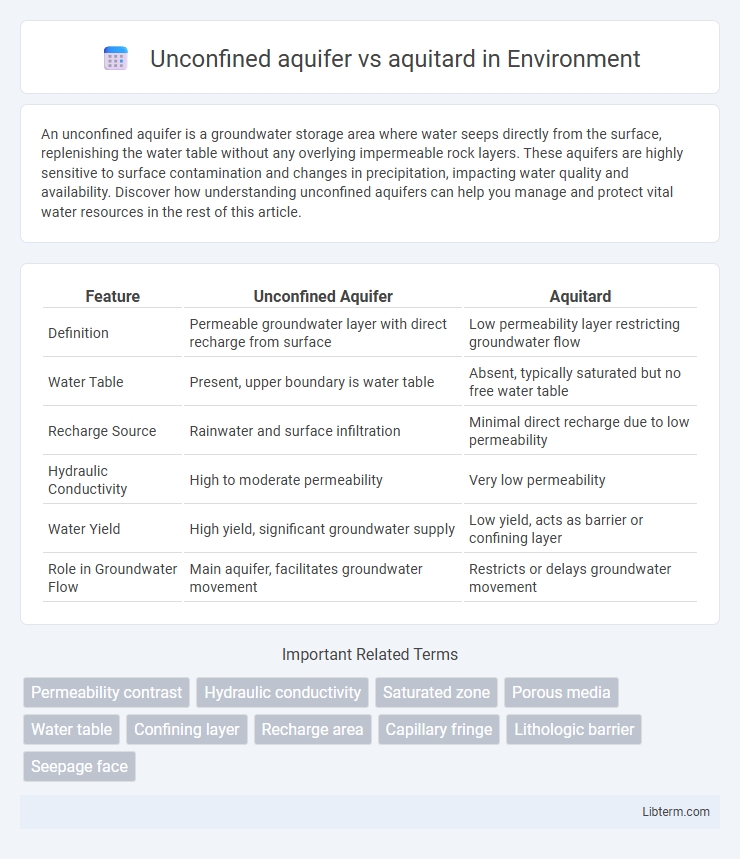An unconfined aquifer is a groundwater storage area where water seeps directly from the surface, replenishing the water table without any overlying impermeable rock layers. These aquifers are highly sensitive to surface contamination and changes in precipitation, impacting water quality and availability. Discover how understanding unconfined aquifers can help you manage and protect vital water resources in the rest of this article.
Table of Comparison
| Feature | Unconfined Aquifer | Aquitard |
|---|---|---|
| Definition | Permeable groundwater layer with direct recharge from surface | Low permeability layer restricting groundwater flow |
| Water Table | Present, upper boundary is water table | Absent, typically saturated but no free water table |
| Recharge Source | Rainwater and surface infiltration | Minimal direct recharge due to low permeability |
| Hydraulic Conductivity | High to moderate permeability | Very low permeability |
| Water Yield | High yield, significant groundwater supply | Low yield, acts as barrier or confining layer |
| Role in Groundwater Flow | Main aquifer, facilitates groundwater movement | Restricts or delays groundwater movement |
Introduction to Unconfined Aquifers and Aquitards
Unconfined aquifers are groundwater reservoirs located directly beneath the Earth's surface with permeable material that allows water to freely infiltrate from above, making them highly responsive to precipitation. Aquitards, in contrast, consist of low-permeability layers such as clay or silt that restrict groundwater flow and act as barriers between aquifers, controlling water movement and storage. Understanding the hydraulic properties of unconfined aquifers versus aquitards is essential for effective groundwater management and contamination risk assessment.
Defining Unconfined Aquifers
Unconfined aquifers are groundwater reservoirs where water is stored in permeable materials like sand and gravel, with the water table exposed directly to the atmosphere through permeable soil. Unlike aquitards, which consist of low-permeability layers such as clay or silt that restrict groundwater flow, unconfined aquifers allow recharge from surface water infiltration. The lack of a confining layer above unconfined aquifers makes them highly responsive to precipitation and surface conditions, making them critical for sustainable groundwater management.
Characteristics of Aquitards
Aquitards are low-permeability geological formations that restrict groundwater flow, often composed of clay, silt, or dense rock layers. Unlike unconfined aquifers, which have permeable materials allowing water to move freely, aquitards act as barriers that slow down or prevent water transmission between aquifers. These properties make aquitards essential in controlling aquifer recharge rates and protecting groundwater quality by limiting contaminant migration.
Formation and Structure
Unconfined aquifers form where permeable materials such as sand and gravel lie directly beneath the earth's surface, allowing water to saturate the zone above the water table. In contrast, aquitards consist of low-permeability layers like clay or shale that restrict water flow and separate or confine aquifers. The structural difference lies in unconfined aquifers having a free water surface exposed to atmospheric pressure, while aquitards act as barriers limiting vertical groundwater movement.
Water Movement and Permeability
Unconfined aquifers have high permeability, allowing water to move freely through porous sediments such as sand and gravel. In contrast, aquitards consist of low-permeability materials like clay or silt, which restrict water flow and act as barriers to groundwater movement. The difference in permeability between unconfined aquifers and aquitards directly impacts groundwater recharge rates and contaminant transport.
Storage Capacity and Yield
Unconfined aquifers exhibit high storage capacity due to the saturated porous materials directly beneath the water table, enabling significant groundwater yield. Aquitards possess low permeability layers that limit water flow, resulting in minimal storage capacity and restricted yield. The contrasting hydraulic properties between unconfined aquifers and aquitards critically influence groundwater availability and extraction rates.
Recharge and Discharge Processes
Unconfined aquifers directly receive recharge from surface water infiltration, allowing rapid groundwater replenishment through precipitation and surface runoff. In contrast, aquitards act as semi-permeable barriers that significantly restrict vertical water movement, limiting recharge rates and influencing discharge by directing groundwater flow laterally. Recharge in unconfined aquifers predominantly occurs via percolation through soil, whereas discharge often happens through springs or wells, while aquitards primarily modulate the timing and quantity of water movement between adjacent permeable layers.
Importance in Groundwater Management
Unconfined aquifers play a critical role in groundwater management by providing easily accessible water sources due to their direct recharge from surface water. In contrast, aquitards act as natural barriers that limit water flow between aquifers, enhancing the control and sustainability of groundwater extraction. Understanding the interaction between unconfined aquifers and aquitards is essential for effective contamination prevention and maintaining groundwater quality.
Common Examples and Occurrences
Unconfined aquifers commonly occur in alluvial plains and river valleys, where permeable materials like sand and gravel allow groundwater to be directly recharged by precipitation. Aquitards, such as layers of clay or shale, frequently separate aquifers by restricting water flow, often found in sedimentary basins like the Mississippi Delta. These contrasting formations illustrate the dynamic interaction between water-bearing permeable strata in unconfined aquifers and low-permeability confining layers characteristic of aquitards.
Key Differences: Unconfined Aquifer vs Aquitard
Unconfined aquifers are permeable geological formations saturated with groundwater where water levels can fluctuate freely with atmospheric pressure, while aquitards are semi-permeable layers that restrict groundwater flow and act as barriers between aquifers. The key difference lies in permeability and water movement; unconfined aquifers allow significant water infiltration and storage, whereas aquitards limit vertical water flow due to lower hydraulic conductivity. Understanding these distinctions is critical for groundwater management, influencing well placement, recharge rates, and contamination risk assessments.
Unconfined aquifer Infographic

 libterm.com
libterm.com